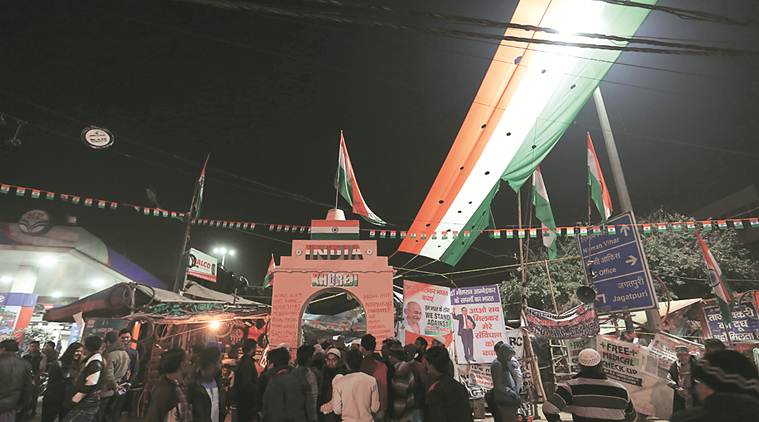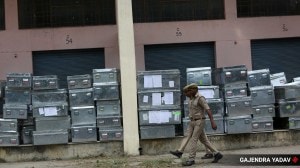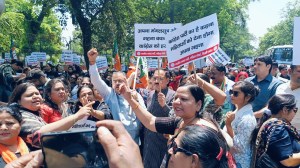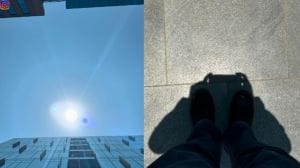- India
- International
Khureji to Turkman Gate, capital’s other Shaheen Baghs
Residents of Khureji, with women at the forefront, have been holding an indefinite 24x7 sit-in at their locality since January 13. People entering the enclosure walk through a model of the India Gate with ‘India’ written in large saffron, white and green letters on it.
 At Khureji Khas on Sunday. (Express Photo: Gajendra Yadav)
At Khureji Khas on Sunday. (Express Photo: Gajendra Yadav)
“If we want to drink water, we can’t sit by a well and wait for the water to come to us. We have to put a bucket in and then drink the water. If we want something, we have to take it ourselves,” a young burkha-clad woman at the mic said to a group of women of all ages sitting inside a large canopied enclosure at East Delhi’s Khureji Khas.
Residents of Khureji, with women at the forefront, have been holding an indefinite 24×7 sit-in at their locality since January 13. People entering the enclosure walk through a model of the India Gate with ‘India’ written in large saffron, white and green letters on it. A Tricolour flaps in the breeze atop it.

Over the last two weeks, 24/7 protest sit-ins drawing large numbers — along the lines of the now iconic protest at Shaheen Bagh — have formed and grown across Delhi: from Inderlok in West Delhi; Hauz Rani in South Delhi; Turkman Gate in Old Delhi; to Khureji in East Delhi; and Wazirabad in North Delhi. However, it is in North East Delhi that the numbers are highest, with 24×7 sit-ins every few kilometres — Chand Bagh, Bhajanpura, Old Mustafabad, Yamuna Vihar, Kardampuri, Khajuri Khas, Seelampur and Jaffrabad. New iterations of this form of protest against the CAA and NRC are being mobilised across the city every few days, and each can be spotted by the Tricolours which surround it.
Of these the oldest is the one at Khureji. “Several of us from the area had been going to Shaheen Bagh to join the protest there, but it was very far for us to go regularly. There was also a fire in people here, so we thought why not start our own protest here. Students from the area set down mats and began the protest and the numbers have grown from a few hundred on the first night to a few thousand every night,” said a 40-year-old woman, who only wanted to be identified as ‘Hindustani’.
On the proliferation of such sites in the city, she laughed and said, “It’s almost as if people have options now. If they want to join the protest, they can join whichever site is closest to them.”

On the other hand, there are far more recent protests such as the one in Yamuna Vihar and Nizamuddin. On Friday, there were a few hundred people in a small enclosure by the road at Yamuna Vihar. The 24/7 protest had begun on Wednesday.
“We were doing smaller protests here every evening but we decided to start a 24×7 protest after seeing that there were large sit-ins happening in all our neighbouring localities in all directions. We drew strength and confidence from them,” said a male resident of the area.
Across these sites, women say they were shaken into wanting to take action after the violence at Jamia university last month, when several students were injured in a police crackdown inside the university. “Our entire struggle is about our children. We are afraid about their future. What they did to the children at Jamia was terrible; we have to fight for them,” said Varsha Farzana (33), sitting at the protest in Inderlok with her sister and sister-in-law.
The protest there started on January 19, and has been set up on a service lane near the Inderlok Metro station right next to the main road.
At all the sites, women are present round the clock but the gathering grows largest in the evening and through the night. In the morning, many women leave to get their children ready for school and complete their household work. “Men have no work here. We are fighting for our children and we sit in front,” said Gulnaz Saifi (55), sitting at the protest in Old Mustafabad, which started on January 18.
At that protest site, an entire support set up has been created behind the enclosure sheltering the women. A kitchen has been set up to prepare food for them, a tea-maker sits through the day sending, and a storeroom houses food supplies contributed by locals and is manned by men.
“Women are at the front everywhere because this is our peaceful protest. We don’t want anypathar-baazi or any violence. We know that police are more likely to crack down on men protesting,” said Niki (31).
Across venues, most women say they are fighting for their rights. Students and professors from Jamia, JNU and DU and lawyers have been going to the different sites and speaking from the stages. “When we first started our protest here, some of the older women were not in support because they were afraid for our safety. They are slowly joining in larger numbers every day. We are trying our best to explain the details of the issue to them but even today, many only say that they are fighting for their rights. But over the last few days, listening to the speakers here, most people’s understanding has grown and sharpened,” said Ramsha (20), at the site in Kardampuri, where the sit-in began on January 18.
At the protest at Turkman Gate, women read Surah Ya-Sin together and are clear that they will not move till the Act is rolled back. “Yeh kanoon humse jhela nahin jaayega. We have tolerated a lot in the last few years. But now they have come after our citizenship,” said Jameela (54).
“Kaagaz kahaan se laayenge? Aur agar kaagaz hai bhi, hum nahi dikhaayenge,” said Zeenat (60).
Apr 24: Latest News
- 01
- 02
- 03
- 04
- 05







































